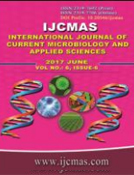


 National Academy of Agricultural Sciences (NAAS)
National Academy of Agricultural Sciences (NAAS)

|
PRINT ISSN : 2319-7692
Online ISSN : 2319-7706 Issues : 12 per year Publisher : Excellent Publishers Email : editorijcmas@gmail.com / submit@ijcmas.com Editor-in-chief: Dr.M.Prakash Index Copernicus ICV 2018: 95.39 NAAS RATING 2020: 5.38 |
The study employed a Stochastic Frontier Production approach to find the determinants that can enhance the production of rice in the Southern zone of Tamil Nadu. The data collected for two years (2009-10 and 2010-11) under the Cost of Cultivation Scheme of Tamil Nadu Centre were used for the study. The results of stochastic production function indicate the input variables seed, fertilizer nutrients (NPK), labour hours, Machine hours and pesticide are significant and hence, playing a major role in rice production. The coefficient of seed is negative and highly significant indicating that to get better yield in tank irrigated farms the farmers may reduce the usage of seed. The coefficient of pesticide is also negative and highly significant indicates that to increase the yield we could reduce the pesticide usage since, it will lead to soil damage. It is advisable to increase the usage of labour and machine hours in tank irrigated farms to get better yield. The average fertilizer (NPK) rate is 203.4 kg per acre which is higher than the recommended level of 114 kg of NPK nutrients. However, proper combination of N, P, and K as recommended is 114 kg of NPK. The results of inefficiency model suggest that the age of the head of household increases the inefficiency level decreases. Rice farmers are 14 percent technically inefficient, implying that little potential exists that can be explored through improvement in resource use efficiency.
 |
 |
 |
 |
 |